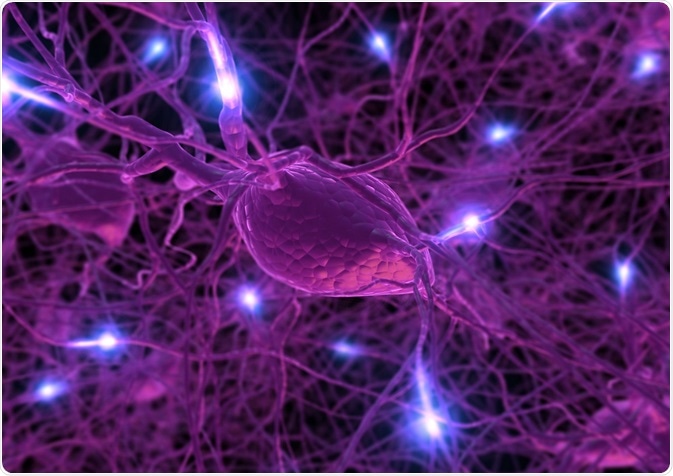There are many different types of neuronal cells, which communicate through a highly complex grid of connections. Neuronal development is guided by many factors, one of which is the protein PRDM16.
 Image Credit: Sebastian Kaulitzki / Shutterstock
Image Credit: Sebastian Kaulitzki / Shutterstock
Nerve cells originate from neural stem cells which differentiate into neurons throughout embryonic development, some of which continue to replicate throughout the life to form new cells and enable learning. The cells produced by these stem cells include neurons and glia, such as astrocytes and oligodendrocytes.
PRDM16 and the maintenance of neural stem cells
To be able to develop into aforementioned diverse neuronal cells, neural stem cell stores must be maintained and differentiation must be prevented to ensure that there is always a store of either multipotent adult stem cells or pluripotent embryonic stem cells. If this store is lost, premature aging and disease can occur, highlighting the importance of this process.
Such maintenance is achieved through a variety of mechanisms, such as maintaining low levels of reactive oxygen species (ROS) and genomic integrity, altering cellular energetics, as well as suppressing lineage commitment through a variety of signaling pathways.
These signaling pathways are complex and involve various components – including the FoxO family of transcription factors, DNA-repair genes, and the Polycomb family.
Once stimulated, neuronal cells may develop to form highly specialized cells which carry out a wide range of functions. These differentiated neuronal cells must then be organized correctly to allow the highly complex signaling processes to be carried out.
The role of PRDM16 in the brain
One important protein which has recently been identified to maintain and control the differentiation of neural stem cells is PRDM16. This protein is expressed in these stem cell stores to allow oxidative stress regulation and to control the organization of differentiated neurons within the brain.
The protein PR domain-containing (PRDM) family has 16 members, all with important roles in transcription as zinc finger transcription factors. The PRDM16 protein was initially identified in a cancer study, where a truncation mutation was found to be implicated in leukemia.
The gene which codes for this protein has been identified in many different mammalian species and is conserved in each of them, highlighting its importance in development processes. It is present on human chromosome 1p36, producing a protein with four differing isoforms. Additionally, studies have identified that it is only active in stem cells and not in their progeny, again highlighting its importance in neuronal stem cells.
PRDM16 has many protean roles in the body, with the most characterized being control of brown adipocytes and beige cell development. However, recently it has been found to promote stem cell maintenance in the nervous system.
The delivery and use of oxygen is very important within stem cells, to prevent excessively toxic levels of ROS. The PRDM16 protein has recently been found to have a role in this mechanism, functioning to promote the maintenance of stem cell stores. In the absence of this protein, the levels of ROS in the brain increase, depleting the stores of stem cells and leading to excessive cell death.
In several knock-out studies, the end-result of the loss of this gene and its protein has been studied. Tested animals developed cortices, but the organization of these neurons was highly abnormal, possibly revealing a role of PRDM16 in the migration of neuronal cells. It also affected the production of more than 1000 other proteins, silencing genes which were involved in the positioning of neurons.
Therefore, PRDM16 protein is involved in both the maintenance of stem cells and in the positioning of differentiated cells. However, this mechanism is not fully understood and thus future research is hoping to characterize this pathway.
Sources:
- https://www.nature.com/articles/ncb2101
- genesdev.cshlp.org/…/gad.291773.116.full.pdf+html
- https://www.cell.com/neuron/fulltext/S0896-6273(18)30368-4
- www.cell.com/…/S1043-2760(15)00226-X.pdf
Further Reading
- All Stem Cells Content
- Stem Cell Sources, Types, and Uses in Research
- What are Stem Cell Transplants?
- Stem Cell Properties
- What are Stromal Cells?
Last Updated: Jun 26, 2019

Written by
Hannah Simmons
Hannah is a medical and life sciences writer with a Master of Science (M.Sc.) degree from Lancaster University, UK. Before becoming a writer, Hannah's research focussed on the discovery of biomarkers for Alzheimer's and Parkinson's disease. She also worked to further elucidate the biological pathways involved in these diseases. Outside of her work, Hannah enjoys swimming, taking her dog for a walk and travelling the world.
Source: Read Full Article
